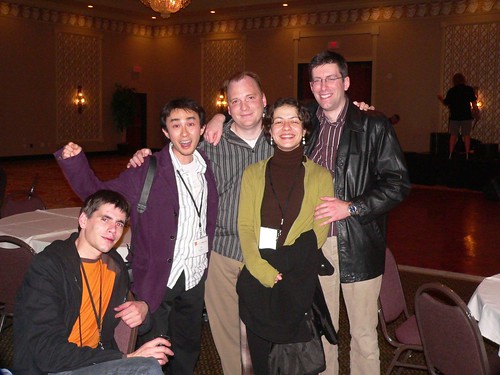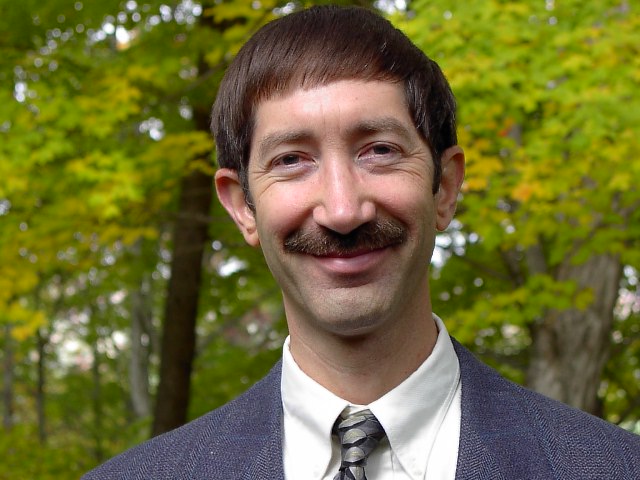
Althought blogging etiqutte seems to be a taboo topic, there must be some rule against blogging after a night of free wine and beer. The folks of Fargo have certainly rolled out the red carpet for this conference; it has been a great time so far.
Since the wine flowed like, well, wine... I will have to confine myself to a quick recap of today's events.
3D Data acquisition3D data acquisition papers covered a few interesting topics. First, Mark Mudge and Carla Schroer at
Cultural Heritage Imaging discussed their method of Reflection Transformation Imaging (RTI). This very cool 3D'ish data capture uses a fixed camera taking approximately 16 pictures with individual light sources set up at different coordinate locations. The output is a series of images that are synthesized into a single image where each 2D pixel encodes the 3D data in the form of illumination direction and lighting characteristics (normals). The RTI viewer displays the 2D image, but allows the user to control the location of the light source with the movement of the mouse. In essence, this displays the topography based on the surface normals. This technique works great for small and fragile objects. The team is working on extending the capabilities so that the RTI map can be applied to a passively collected 3D geometry and viewed with adjustable and accurate lighting with a very low file size. Also, the team had developed an open source, Java based viewer.
Secondly, there was a great 3D acquisition project from the folks at the Center for Advanced Spatial Technology (
CAST) at the
University of Arkansas. Briefly, this team used an optics long range, time of flight laser scanner to perform a High Density Survey of Machu Pichu, Peru and Tiwanaku, Bolivia. Basically, the research group conducted over 225 different scans which included over 150 million points in 13 days (non-consecutive). The resulting point clouds are downloadable, along with a free viewer from polyworks, at
www.cast.uark.edu/invirmetCheck it out!
Agent Based ModelingAgent Based Modeling (ABM) is a topic close to my heart and something I wish to talk about more. Today, I saw few papers on ABM, here is a quick overview of two different approaches. First, Luke Premo, from the
University of Arizona, discussed an exploritory ABM for the Plio-Pleistocene of Africa. The intention of Premo's model is not to create a realistic rendition of real world condition (topography, climate, soils, geology). Instead, his intention is to create a simple model to test (falsify) a contemporary hypothesis. The hypothesis is the Central Place Foraging (CPF) model as applied to early Hominids in East Africa. Premo created a model, entitled SHARE (Simulated Hominid Altruism Research Environment), that embeds rules of food consumption and hominid movement based on a patchwork grassland/forest environment. In the end, Premo replicates the general patterns of artifact distribution (called patches and scatters) that are currently attributed to CPF based on the location of the forest patches. At first glance, it seems obvious that the model would produce a patchwork distribution that corresponds to the patchwork of the forest, therefore making dubious results. But this is primarily what Premo is getting at. In the past, this pattern has been attributed soley to CPF as a consequence of modern ethnographic analogy. His simple model shows that CFP is not the only method that can lead to such an artifact distribution. Not that CFP is falsified, but the SHARE model shows that other things may be at work and that modern ethnographic analogs are not the only correlation. Interesting!
On the other side of the coin, John Murphy, also of the
University of Arizona, detailed the Dynamic Interface Architecture System (DIAS). This system is a framework for the development of integrative ABM models that share data inputs and actions. The DIAS framework can take models of different systems and link them as modules into a large and more conclusive model. For instance, Murphy discussed the ENKIMDU model (a cultural based model of Mesopotamia) and showed how models of climate, soils, and cow herding behavior, which were create for different reasons, could be plugged in using the DIAS system, to the ENKIMDU model. This framework gives the power to take specialized models, created by experts in that field, and plug them in, seamlessly, to your model. According to Premo, this model would be included in the Emulation class of ABMs.
Mobile ApplicationsAnd finally, Claus Dam of the
Danish Heritage Agency, Denmark, displayed the cell phone based locative technology they have developed. In short, this system,
Nordic Handscape, is broken into two aspects. One part of this project is a system for tourists to retrieve museum data, while the other is for professionals and the public to retrieve data on archaeological sites based on their GPS location or their geocoded address. I do not want to see these projects short, but given the time, I will say that they did everything I could have asked them to do. It knows you location, and it will push you the location, data, and interpretation of archaeological sites within a given radius. The part that I find most appealing about his project is that it has a individual interpretation and data collecting aspect that nears social networking. Each user has their own website with their preferences on which the user can upload photos of sites and tell their own stories about these sites. At the end of the talk, there was a very interesting discussion based on this social aspect. One audience member asked what will happen when we allow lay people to edit out "professional" interpretations of archaeological sites? Other audience members jumped to the defense of the democratization of data and welcomed the wiki'esqu nature of the system. I agree with the wiki folks and would enjoy reading interpretations derived from non-archaeologists. The topic of democratized data has been an undertone.
I would love to delve deeper into the topic of what social networks and massively distributed archaeological interpretations could do for our discipline, but that is another day.
Way past my bedtime... Talk to you all tomorrow.





